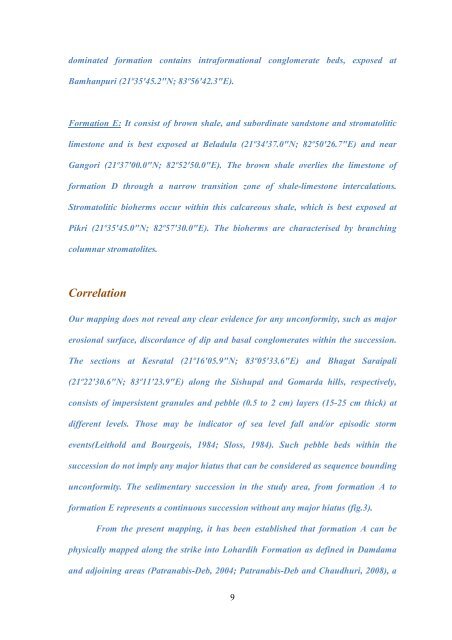of the Singhora-Saraipali area, south-eastern Chattisgarh Basin - fieldi
of the Singhora-Saraipali area, south-eastern Chattisgarh Basin - fieldi
of the Singhora-Saraipali area, south-eastern Chattisgarh Basin - fieldi
Create successful ePaper yourself
Turn your PDF publications into a flip-book with our unique Google optimized e-Paper software.
dominated formation contains intraformational conglomerate beds, exposed at<br />
Bamhanpuri (21º35'45.2"N; 83º56'42.3"E).<br />
Formation E: It consist <strong>of</strong> brown shale, and subordinate sandstone and stromatolitic<br />
limestone and is best exposed at Beladula (21º34'37.0"N; 82º50'26.7"E) and near<br />
Gangori (21º37'00.0"N; 82º52'50.0"E). The brown shale overlies <strong>the</strong> limestone <strong>of</strong><br />
formation D through a narrow transition zone <strong>of</strong> shale-limestone intercalations.<br />
Stromatolitic bioherms occur within this calcareous shale, which is best exposed at<br />
Pikri (21º35'45.0"N; 82º57'30.0"E). The bioherms are characterised by branching<br />
columnar stromatolites.<br />
Correlation<br />
Our mapping does not reveal any clear evidence for any unconformity, such as major<br />
erosional surface, discordance <strong>of</strong> dip and basal conglomerates within <strong>the</strong> succession.<br />
The sections at Kesratal (21º16'05.9"N; 83º05'33.6"E) and Bhagat <strong>Saraipali</strong><br />
(21º22'30.6"N; 83º11'23.9"E) along <strong>the</strong> Sishupal and Gomarda hills, respectively,<br />
consists <strong>of</strong> impersistent granules and pebble (0.5 to 2 cm) layers (15-25 cm thick) at<br />
different levels. Those may be indicator <strong>of</strong> sea level fall and/or episodic storm<br />
events(Leithold and Bourgeois, 1984; Sloss, 1984). Such pebble beds within <strong>the</strong><br />
succession do not imply any major hiatus that can be considered as sequence bounding<br />
unconformity. The sedimentary succession in <strong>the</strong> study <strong>area</strong>, from formation A to<br />
formation E represents a continuous succession without any major hiatus (fig.3).<br />
From <strong>the</strong> present mapping, it has been established that formation A can be<br />
physically mapped along <strong>the</strong> strike into Lohardih Formation as defined in Damdama<br />
and adjoining <strong>area</strong>s (Patranabis-Deb, 2004; Patranabis-Deb and Chaudhuri, 2008), a<br />
9









